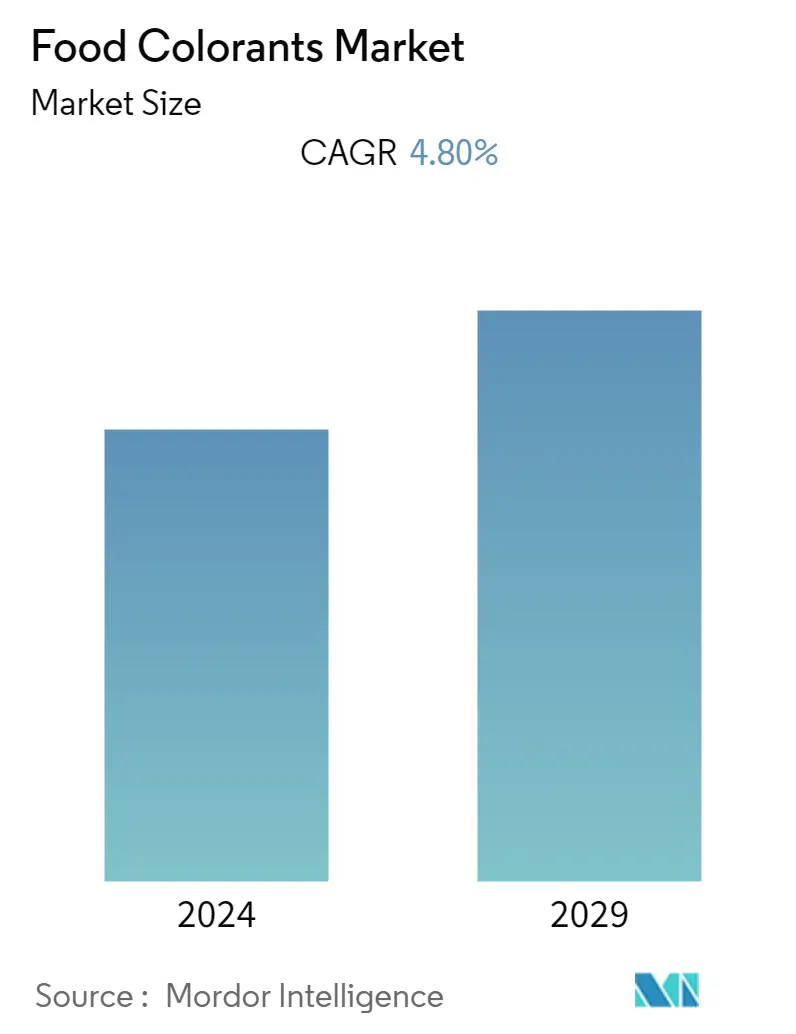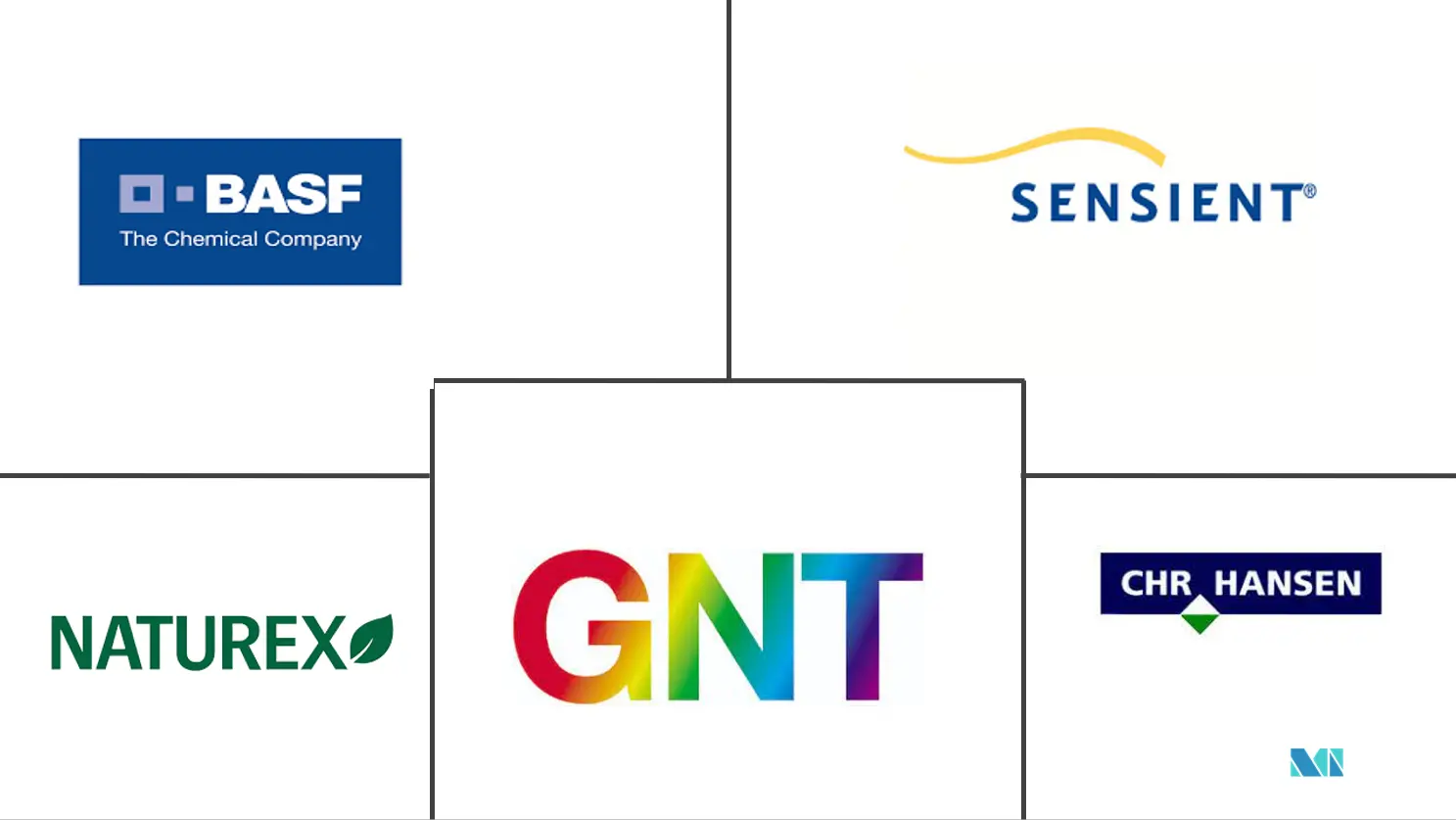Market Size of Food Colorants Industry

| Study Period | 2019 - 2029 |
| Base Year For Estimation | 2023 |
| CAGR | 4.80 % |
| Fastest Growing Market | Asia Pacific |
| Largest Market | Europe |
| Market Concentration | Low |
Major Players
*Disclaimer: Major Players sorted in no particular order |
Food Colorants Market Analysis
The global food colorant market is forecasted to grow with a CAGR of 4.8% during the forecast period (2022- 2027).
Due to the pandemic COVID-19, the food colorant market grew attention towards the natural food color segment as the world's scientific team, as well as the medical team, recommended the use of nutraceuticals to improve health and immunity. The pandemic increased consumers' desire for the quality check of food with good labeling, which gave rise to many private label companies supplying quality fo, od colorants with good labeling. As of COVID-19, the consumers were also ready to pay extra for quality assured and natural products which also affected the natural food colorant market positively to a great extent.
The importance of food colorants has increased in the past few decades with the advent of modern food processing methods, the slightest step of which destroys the natural coloring pigments in food. Adding back what is lost during processing is termed 'food enrichment.' However, this value addition is fulfilled by food additives. Food colorants constitute an important part of food additives.
Food Colorants Industry Segmentation
Global Food Colorants such as natural color and synthetic color are coloring foodstuff. The health-enhancing properties of natural colors, combined with the organic properties in natural products, are releasing the demand for natural colors. Food colors are preparations obtained from foods and other edible natural source materials obtained by physical and/or chemical extraction resulting in selective extraction of the pigments relative to the nutritive or aromatic constituents. By application, the market is segmented as beverages, dairy & frozen products, bakery, meat, poultry, and seafood, confectionery, sauces and condiments, and others; by product type into natural and synthetic. Based on geography, the market is segmented into North America, Europe, Asia-Pacific, South America, and Middle-East and Africa. The report offers market size and forecast in value terms in USD million for all the above segments.
| Product Type | |
| Natural Color | |
| Synthetic Color |
| Application | |
| Beverages | |
| Dairy & Frozen Products | |
| Bakery | |
| Meat, Poultry and Seafood | |
| Confectionery | |
| Sauces and Condiments | |
| Others |
| Geography | |||||||||
| |||||||||
| |||||||||
| |||||||||
| |||||||||
|
Food Colorants Market Size Summary
The global food colorants market is experiencing a notable shift towards natural colorants, driven by increasing consumer demand for health-conscious and minimally processed foods. This trend has been further accelerated by the COVID-19 pandemic, which heightened awareness around food quality and immunity-boosting nutraceuticals. As a result, consumers are willing to invest more in products that offer quality assurance and natural ingredients, positively impacting the natural food colorant segment. The importance of food colorants has grown with modern food processing methods, which often strip away natural pigments, necessitating the use of additives to restore color. This has led to a surge in interest and development of natural colorants, as they offer both health benefits and organic appeal, positioning them to outpace synthetic alternatives in market growth.
The European Union remains a significant player in the food colorants market, with stringent regulations governing the use of color additives, reflecting the region's focus on clean label foods and health awareness. The market is dominated by a few key players, such as Chr Hansen, DD Williamson, and DSM, who are expanding their global presence through mergers and acquisitions, as well as new product developments. These companies leverage their extensive product lines and geographical reach to maintain a competitive edge. Innovations, such as GNT Group's new pink shade and Chr. Hansen's R&D center for natural color solutions, highlight the ongoing advancements in the industry. The market's growth is supported by strategic partnerships and expansions, underscoring the dynamic nature of the food colorants sector.
Food Colorants Market Size - Table of Contents
-
1. MARKET DYNAMICS
-
1.1 Market Drivers
-
1.2 Market Restraints
-
1.3 Porters Five Force Analysis
-
1.3.1 Threat of New Entrants
-
1.3.2 Bargaining Power of Buyers/Consumers
-
1.3.3 Bargaining Power of Suppliers
-
1.3.4 Threat of Substitute Products
-
1.3.5 Intensity of Competitive Rivalry
-
-
-
2. MARKET SEGMENTATION
-
2.1 Product Type
-
2.1.1 Natural Color
-
2.1.2 Synthetic Color
-
-
2.2 Application
-
2.2.1 Beverages
-
2.2.2 Dairy & Frozen Products
-
2.2.3 Bakery
-
2.2.4 Meat, Poultry and Seafood
-
2.2.5 Confectionery
-
2.2.6 Sauces and Condiments
-
2.2.7 Others
-
-
2.3 Geography
-
2.3.1 North America
-
2.3.1.1 United States
-
2.3.1.2 Canada
-
2.3.1.3 Mexico
-
2.3.1.4 Rest of North America
-
-
2.3.2 Europe
-
2.3.2.1 Germany
-
2.3.2.2 United Kingdom
-
2.3.2.3 France
-
2.3.2.4 Italy
-
2.3.2.5 Russia
-
2.3.2.6 Spain
-
2.3.2.7 Rest of Europe
-
-
2.3.3 Asia-Pacific
-
2.3.3.1 India
-
2.3.3.2 China
-
2.3.3.3 Australia
-
2.3.3.4 Japan
-
2.3.3.5 Rest of Asia-Pacific
-
-
2.3.4 South America
-
2.3.4.1 Brazil
-
2.3.4.2 Argentina
-
2.3.4.3 Rest of South America
-
-
2.3.5 Middle-East and Africa
-
2.3.5.1 United Arab Emirates
-
2.3.5.2 South Africa
-
2.3.5.3 Rest of Middle-East and Africa
-
-
-
Food Colorants Market Size FAQs
What is the current Food Colorants Market size?
The Food Colorants Market is projected to register a CAGR of 4.80% during the forecast period (2024-2029)
Who are the key players in Food Colorants Market?
Sensient Technologies Corporation, Chr. Hansen Holding A/S, BASF SE, Naturex S.A and GNT Group are the major companies operating in the Food Colorants Market.

